Nigeria Third-Party Logistics (3PL) Market Size
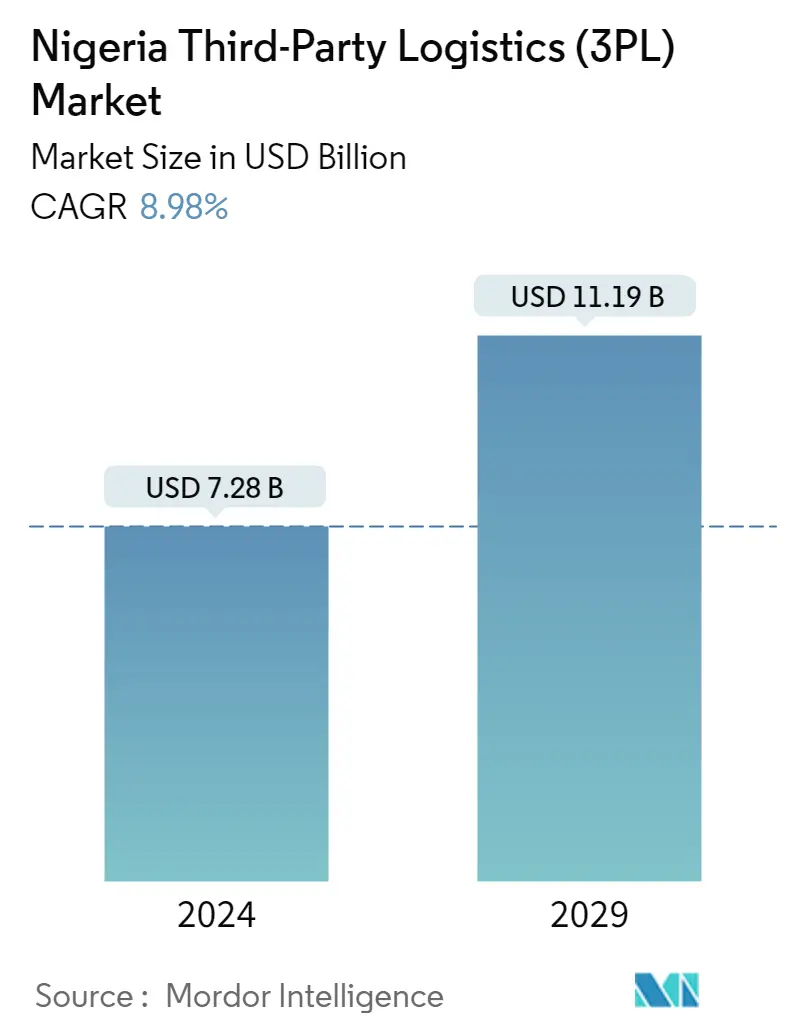
| Study Period | 2020 - 2029 |
| Base Year For Estimation | 2023 |
| Market Size (2024) | USD 7.28 Billion |
| Market Size (2029) | USD 11.19 Billion |
| CAGR (2024 - 2029) | 8.98 % |
| Market Concentration | Low |
Major Players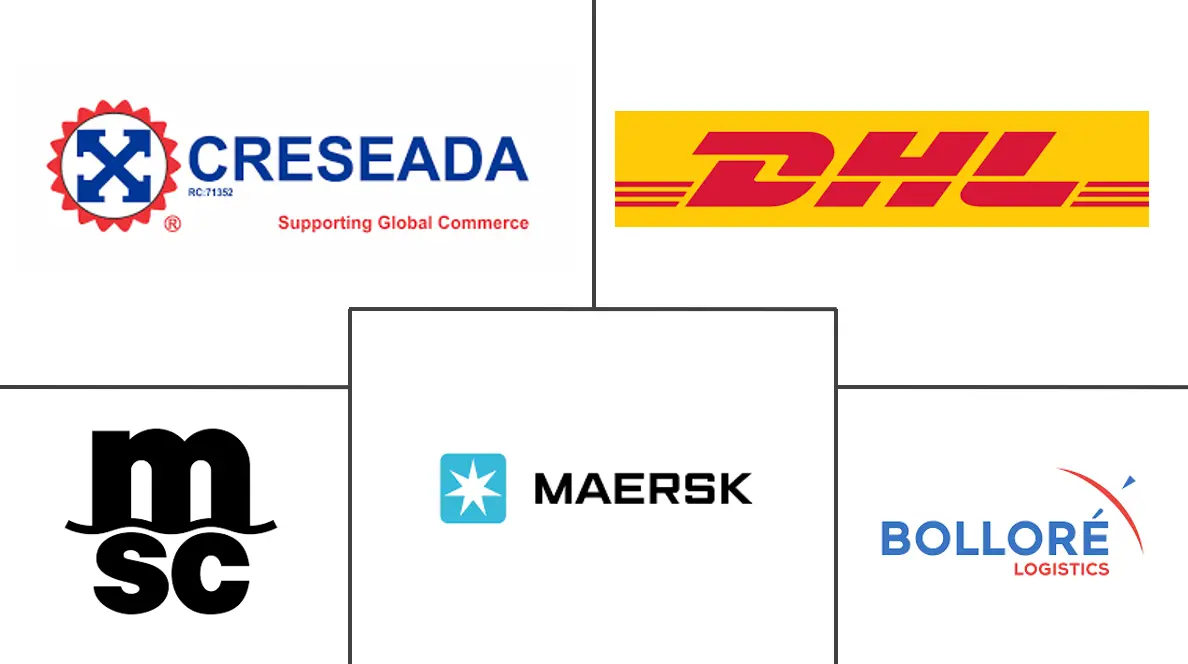
*Disclaimer: Major Players sorted in no particular order |
Nigeria Third-Party Logistics (3PL) Market Analysis
The Nigeria Third-Party Logistics Market size is estimated at USD 7.28 billion in 2024, and is expected to reach USD 11.19 billion by 2029, growing at a CAGR of 8.98% during the forecast period (2024-2029).
- COVID-19 severely impacted the Nigeria 3PL Market as the supply chains were disrupted worldwide. The growth of the Nigeria 3PL The growth of intra-continental trade through the African Continental Free Trade Agreement (AfCFTA) is what fuels the growth of the Nigerian 3PL market. Moreover, the growth in the manufacturing sector and the change in consumption patterns contribute to market growth, which has increased demand for logistics services.
- The main economic constraints are infrastructure gaps and disjointed supply chains among the nations. African countries have to strategically and heavily invest in their infrastructure.
- Along with the infra development, the synchronization of regulations related to different sectors (such as pharmaceutical products) and sub-regional blocks is necessary to support trade and a favorable business climate.
- Nigeria's logistics sector is expanding due to infrastructure development in railways and airways, improved ties with other countries, growth in the manufacturing and export sectors, and e-commerce.
- According to a survey conducted by the Lagos Chamber of Commerce and Industry, the Nigerian economy lost an estimated annual revenue of 3.46 trillion naira (USD 8.4 billion) due to poor infrastructure, poor implementation, and corruption at ports, of which 2.5 trillion naira (USD 6 billion) are corporate earnings losses across the economy.
- According to the report, profit margins of corporate entities that use some of the country's key infrastructure, such as the Apapa port, have gradually shrunk as logistics costs have risen significantly.
- In the first quarter of 2021, Apapa port handled the majority of export transactions, with goods worth 2.58 trillion nairas (USD 6 billion), accounting for 88.91% of total exports. Port Harcourt came in second with 167.29 billion nairas (USD 406 million), or 5.75%. Revenue at Mohammed Murtala International Airport increased by 2.5% to 75.4 billion naira (USD 183 million).
- In terms of imports, Apapa Port had the most transactions, valued at 2.92 trillion nairas (USD 7.1 billion), accounting for 42.73% of total imports. Tin Can Island came in second with 1.2 trillion nairas (USD 2.9 billion) or 17.95%, Port Harcourt came in third with 691.7 billion nairas (USD 1.6 billion) or 10.10%, and Muhammed Murtala International Airport came in third with 625.7 billion nairas (USD 1.52 billion) or 9.13%.
Nigeria Third-Party Logistics (3PL) Market Trends
This section covers the major market trends shaping the Nigeria Third-Party Logistics (3PL) Market according to our research experts:
AfCFTA to Increase Intra Regional Trade
The intra-Africa trade was currently limited to 15% of Africa's total trade, indicating a fragile intra-regional value chain compared to Asia, which is at 80%. With the introduction of the African Continental Free Trade Agreement (AfCFTA), the world's largest free trade zone signed by 54 countries and expected to revolutionize trade across the continent, the trade volume and hence the economy of the continent is expected to grow significantly.
The agreement will focus on increasing production capabilities in an exceedingly competitive global landscape. With the agreement implemented, the manufacturing and production of essentials and value-added products will increase, improving economic diversification and accelerating structural transformation, increasing investments, and decreasing the dependence on labor forces. Thus, shaping the competitiveness of the African economy through productivity gains.
According to the World Bank, if fully implemented to harmonize investment and competition rules, the trade pact could increase regional income by up to 9%, to USD 571 billion. It has the potential to generate nearly 18 million new jobs, many of which will be higher-paying and higher quality, with women benefiting the most. The resulting job and income growth could help up to 50 million people escape extreme poverty by 2035.
According to the report, Making the Most of the African Continental Free Trade Area, increased FDI could boost Africa's exports by up to 32% by 2035, with intra-African exports increasing by 109%, particularly in the manufactured goods sector. Tunisia (165%), Cameroon (144%), Ghana (132%), Tanzania (126%), and South Africa (61%) will all see an increase in intra-African exports.
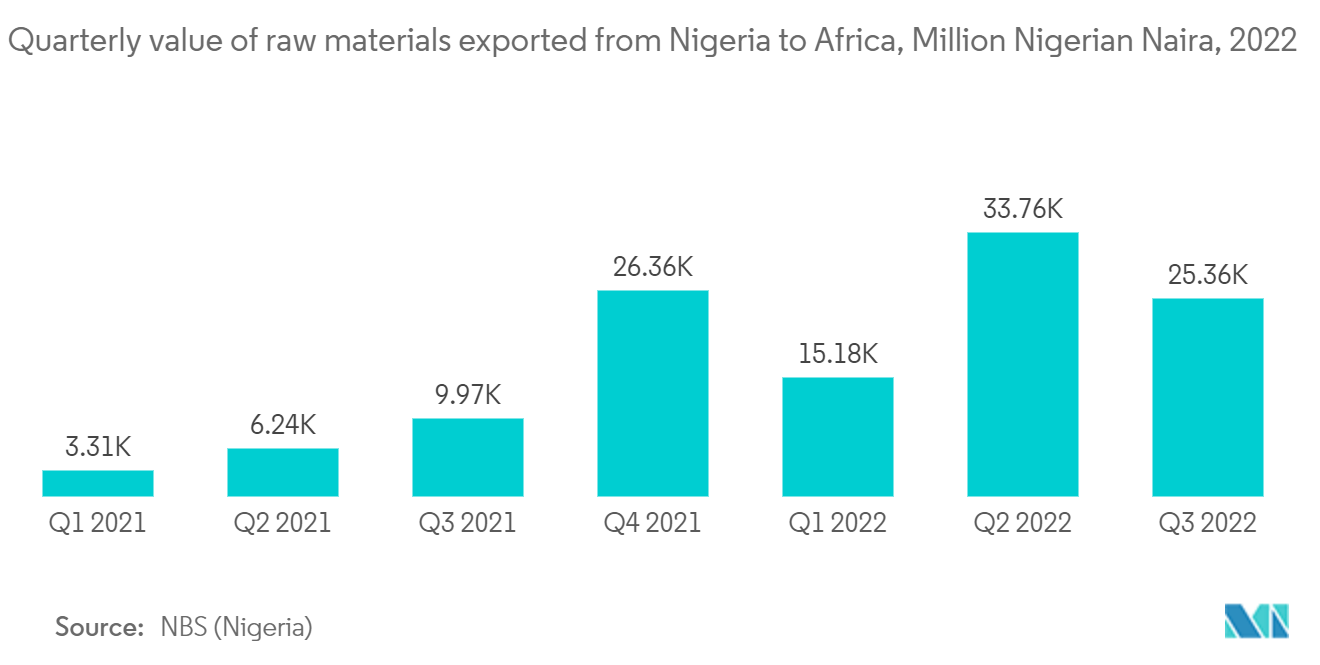
Increased manufacturing output and exports in Nigeria
The project Make in Nigeria for Export (MINE) is a presidential initiative to develop the "world-class" Special Economic Zones (SEZs) across Nigeria and boost the manufacturing of "Made in Nigeria" goods for export, regionally and globally.
The project aims to increase the manufacturing sector's contribution to GDP to about 20%, create 1.5 million new direct jobs and generate over USD 30 billion yearly by 2025. The Federal Executive Council (FEC), the Economic Management Team (EMT), and Project MINE's Steering Committee the country will be working under the sustainable Public-Private Partnership (PPP) model to develop SEZs across Nigeria.
According to the National Bureau of Statistics (NBS), Nigeria's manufacturing sector grew by 5.89% (year on year) in real terms in Q1 2022, an increase of 3.61% from the previous quarter's growth rate of 2.28%. The sector's nominal GDP growth rate was 11.72% year on year in Q1 2022, a decrease of 20.38% from the same quarter in 2021 (32.10%). The sector contributed 10.20% to overall GDP in real terms in Q1 2022, up from 9.93% in the first quarter of 2021 but down from 8.46% in the fourth quarter of 2021.
Manufacturing encompasses the production of cement, food, drinks, and tobacco products; textiles, clothes, and footwear; wood and wood products; pulp paper and paper goods; chemicals; and pharmaceuticals. The manufacturing sector also includes the manufacturing of non-metallic products, plastic and rubber goods, electrical and electronic goods, basic metals and iron and steel, motor vehicles and their assembly, and other goods.
According to the Q1 2022 GDP report, the manufacturing sector grew by 5.89% year-on-year, an increase of 2.49% over the same period in 2021 and 3.61% points over the previous quarter in Q4 2021. In nominal terms, the sector's growth rate was -2.96% quarter on quarter. However, the sector's growth rate in real terms was 2.85% quarter-on-quarter.
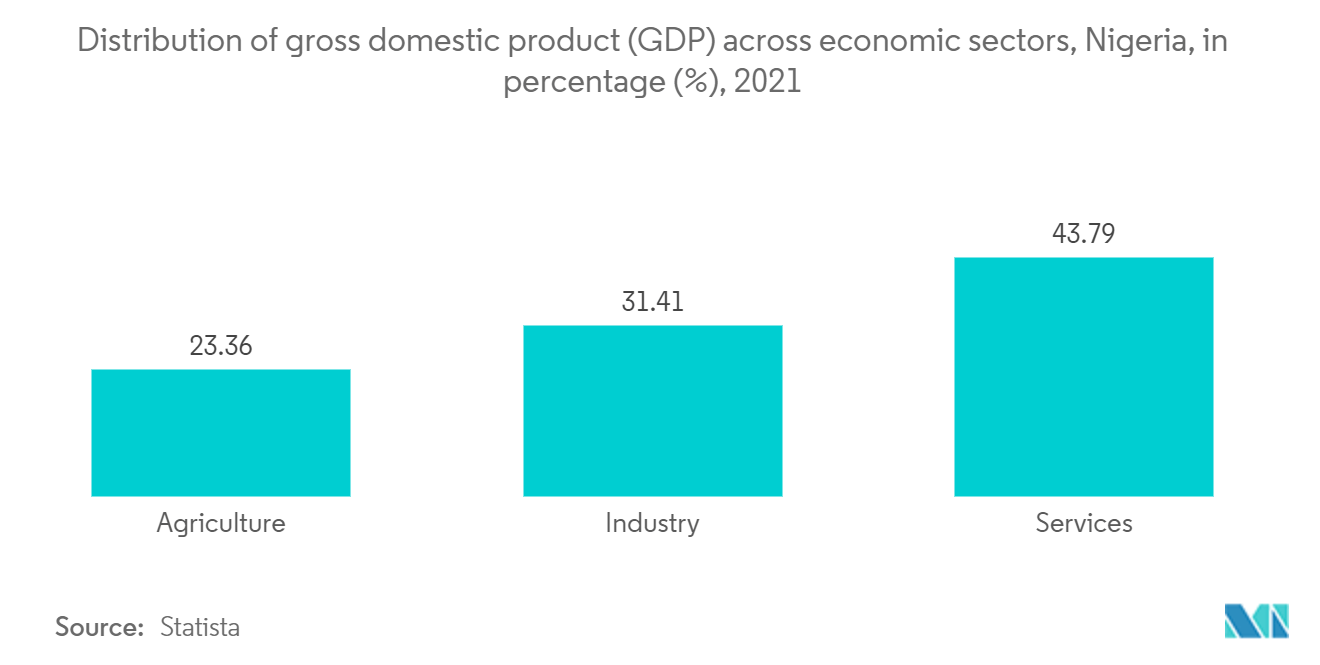
Nigeria Third-Party Logistics (3PL) Industry Overview
The Nigeria Third-Party Logistics (3PL) Market is highly fragmented with a large number of local and international players such as FedEx, UPS, GMT Logistics, Maersk, DHL International GmbH, Creseada International Limited, Bollore Transport and Logistics, MSC (Mediterranean Shipping Company and many more as its key players. Given the vast population and regulatory changes in the economy, the country expects speedy growth in the coming years. Companies globally are investing in developing their business in the country to grasp the opportunity.
Nigeria Third-Party Logistics (3PL) Market Leaders
-
Maersk
-
DHL International GmbH.
-
Creseada International Limited
-
Bollore Transport and Logistics
-
MSC (Mediterranean Shipping Company)
*Disclaimer: Major Players sorted in no particular order
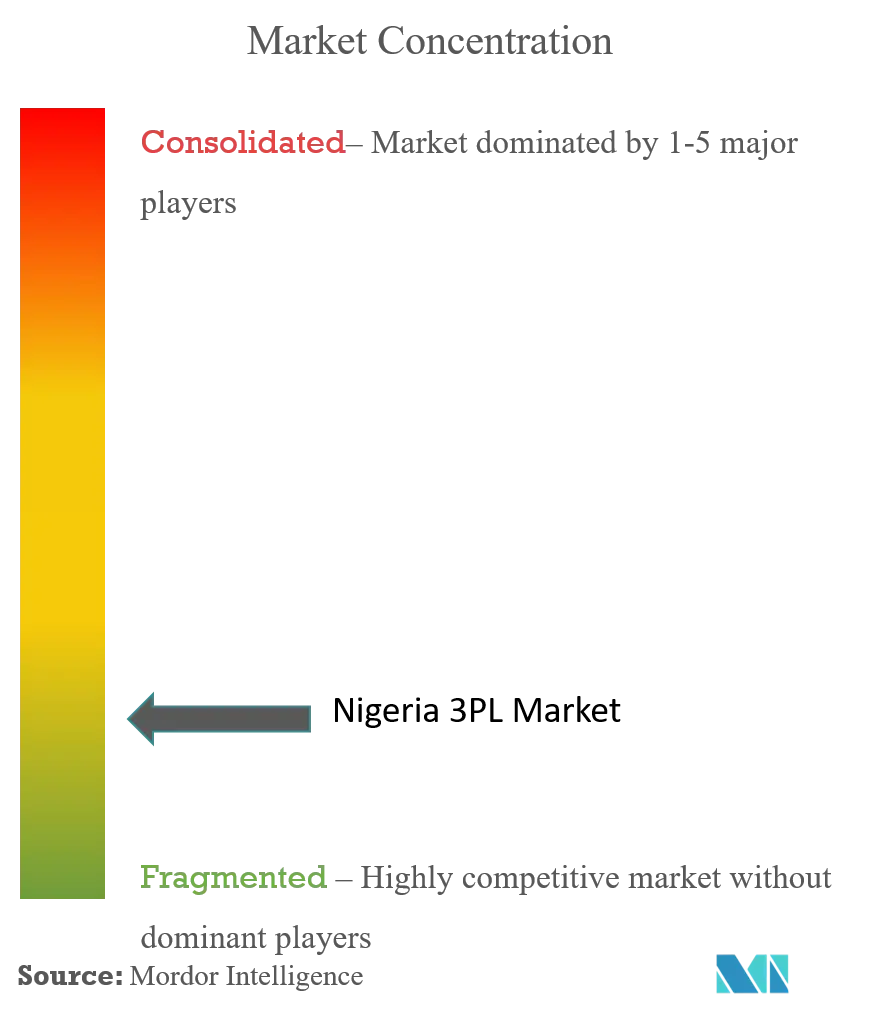
Nigeria Third-Party Logistics (3PL) Market News
- June 2022: Following the exclusive negotiations announced on 20 December 2021 and the favorable opinions issued by each of the consulted employee representative bodies, the Bollore Group signed an agreement with the MSC Group for the sale of 100% Bolloré Africa Logistics, comprising Bollore Group's transport and logistics activities in Africa, on the basis of an enterprise value, net of minority interests, of 5.7 billion euros (6.07 USD billion).
- January 2022: Kuehne+Nagel, expanded its network of African offices, which are managed and supported by a control tower in Durban, South Africa. The regional control tower acts as a single point of contact for an integrated network that spans the continent, allowing for complete visibility, including remote locations, while upholding Kuehne+Nagel's global service standards and monitoring data quality.
Nigeria Third-Party Logistics (3PL) Market Report - Table of Contents
1. INTRODUCTION
1.1 Study Assumptions
1.2 Scope of the Study
2. RESEARCH METHODOLOGY
2.1 Analysis Methodology
2.2 Research Phases
3. EXECUTIVE SUMMARY
4. MARKET INSIGHTS AND DYNAMICS
4.1 Current Market Scenario
4.2 Market Overview
4.3 Market Dynamics
4.3.1 Drivers
4.3.2 Restraints
4.3.3 Opportunities
4.4 Value Chain / Supply Chain Analysis
4.5 Porter's Five Forces Analysis
4.5.1 Threat of New Entrants
4.5.2 Bargaining Power of Buyers/Consumers
4.5.3 Bargaining Power of Suppliers
4.5.4 Threat of Substitute Products
4.5.5 Intensity of Competitive Rivalry
4.6 Value Chain / Supply Chain Analysis
4.7 Industry Policies and Regulations
4.8 General Trends in Warehousing, CEP, Last Mile Delivery, Cold Chain Logistics Etc.
4.9 Insights on E-commerce Business
4.10 Technological Developments in the Logistics Sector
4.11 Impact of Covid-19 on the Market
5. MARKET SEGMENTATION
5.1 By Service
5.1.1 Domestic Transportation Management
5.1.2 International Transportation Management
5.1.3 Value-added Warehousing and Distribution
5.2 By End-User
5.2.1 Manufacturing & Automotive
5.2.2 Oil & Gas and Chemicals
5.2.3 Distributive Trade (Wholesale and Retail trade including e-commerce)
5.2.4 Pharma & Healthcare
5.2.5 Construction
5.2.6 Other End Users
6. COMPETITIVE LANDSCAPE
6.1 Market Concentration Overview
6.2 Company Profiles
6.2.1 Maersk Line
6.2.2 DHL International GmbH.
6.2.3 Creseada International Limited
6.2.4 Bollore Transport and Logistics
6.2.5 MSC (Mediterranean Shipping Company)
6.2.6 ABC Transport
6.2.7 LOGISTIQ XPEDITORS LIMITED
6.2.8 REDOXCORP SHIPPING & LOGISTICS LIMITED
6.2.9 GWX
6.2.10 Redline Logistics
6.2.11 AGS Movers Lagos
6.2.12 UPS (United Postal Services)*
- *List Not Exhaustive
7. FUTURE OF NIGERIA 3PL MARKET
8. APPENDIX
Nigeria Third-Party Logistics (3PL) Industry Segmentation
A 3PL (third-party logistics) provider provides outsourced logistics services, which include the management of one or more aspects of procurement and fulfillment activities. This report includes a complete background analysis of the Nigeria Third-Party Logistics (3PL) Market, including the assessment of the economy and contribution of sectors in the economy, market overview, market size estimation for key segments, and emerging trends in the market segments, market dynamics, and geographical trends, and COVID-19 impact.
The Nigeria third-party logistics (3PL) market is segmented by type (domestic transportation management, international transportation management, and value-added warehousing and distribution) and by end-users (manufacturing and automotive, oil and gas, and chemicals, distributive trade(wholesale and retail trade including e-commerce), pharma and healthcare, construction, and other end users). The report offers market size and forecasts for the Nigeria Third-Party Logistics (3PL) Market in value (USD Billion) for all the above segments.
| By Service | |
| Domestic Transportation Management | |
| International Transportation Management | |
| Value-added Warehousing and Distribution |
| By End-User | |
| Manufacturing & Automotive | |
| Oil & Gas and Chemicals | |
| Distributive Trade (Wholesale and Retail trade including e-commerce) | |
| Pharma & Healthcare | |
| Construction | |
| Other End Users |
Nigeria Third-Party Logistics (3PL) Market Research FAQs
How big is the Nigeria Third-Party Logistics (3PL) Market?
The Nigeria Third-Party Logistics (3PL) Market size is expected to reach USD 7.28 billion in 2024 and grow at a CAGR of 8.98% to reach USD 11.19 billion by 2029.
What is the current Nigeria Third-Party Logistics (3PL) Market size?
In 2024, the Nigeria Third-Party Logistics (3PL) Market size is expected to reach USD 7.28 billion.
Who are the key players in Nigeria Third-Party Logistics (3PL) Market?
Maersk, DHL International GmbH., Creseada International Limited, Bollore Transport and Logistics and MSC (Mediterranean Shipping Company) are the major companies operating in the Nigeria Third-Party Logistics (3PL) Market.
What years does this Nigeria Third-Party Logistics (3PL) Market cover, and what was the market size in 2023?
In 2023, the Nigeria Third-Party Logistics (3PL) Market size was estimated at USD 6.68 billion. The report covers the Nigeria Third-Party Logistics (3PL) Market historical market size for years: 2020, 2021, 2022 and 2023. The report also forecasts the Nigeria Third-Party Logistics (3PL) Market size for years: 2024, 2025, 2026, 2027, 2028 and 2029.
Nigeria Third Party Logistics Industry Report
The Nigeria Third-Party Logistics (3PL) market is segmented by type into domestic transportation management, international transportation management, and value-added warehousing and distribution. It is also segmented by end-users, including manufacturing and automotive, oil and gas, and chemicals, distributive trade (wholesale and retail trade including e-commerce), pharma and healthcare, construction, and other end users. The market size and forecasts for the Nigeria Third-Party Logistics (3PL) Market are provided in terms of value for all the above segments.
This industry overview provides a comprehensive market overview, highlighting the market share, market size, and industry trends. The industry analysis delves into the market growth and market trends, offering insights into the industry growth and industry statistics. The report includes a detailed market forecast outlook and a historical overview, making it a valuable industry report.
The market growth is driven by various factors, and the report sheds light on the market leaders and market research companies involved. The market segmentation covers different end-users, providing a clear market value and market data. The industry outlook is positive, with market predictions indicating robust growth.
The report example and report PDF download offer a glimpse into the detailed industry research and industry sales. The industry information and industry reports provide an in-depth market review, emphasizing the market outlook and market predictions. The report also includes industry statistics and industry trends, making it an essential resource for understanding the market dynamics.
In summary, the Nigeria Third-Party Logistics (3PL) market is poised for significant growth, with a detailed market forecast and industry analysis available in the report. The market segmentation and market value are thoroughly covered, providing a comprehensive market review and market data. The report PDF download offers an easy-to-access format for industry research and market predictions.



